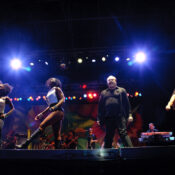The New Wave of British Heavy Metal (NWOBHM) began in the U.K. in the late 1970s and unlocked worldwide success for a number of acts in the following years. Hitting just prior to the launch of MTV in 1981, NWOBHM resulted in a number of bands that were ready for the rock-friendly early days of the channel. While the scene had been rolling across the pond for several months, the American flashpoint came in April of 1980, particularly April 14, when two important albums were released on the same day: British Steel by Judas Priest, and the self-titled debut of Iron Maiden.
Heavy Metal as a concept might evoke particular images, but it’s a broad genre. In the documentary film, Metal: A Headbanger’s Journey, anthropologist Sam Dunn enumerates 24 distinct subgenres of metal on the “definitive metal family tree.” Each subgenre is associated by specific sounds, looks, and, occasionally, points of origin. The epicenter for NWOBHM was the rock club The Bandwagon in Kingsbury, North London, a venue managed by touring DJ Neal Kay. In May of 1979, British journalist Geoff Barton wrote about the scene in Sounds magazine; Barton and his editor Alan Lewis dubbed the bands that orbited the area the New Wave of British Heavy Metal. That article resulted in Kay being deluged with demo tapes of bands that wanted to be a part of the movement. Bands that were making their breakthrough included Saxon and Iron Maiden.
In the United States, music was in a state of flux. Of the new musical genres of the 1970s, disco seemed dead, hip-hop was just beginning to make inroads, and labels that deemed punk a losing commercial proposition were trying to repackage those signed bands (like Blondie and Talking Heads) as “New Wave.” A number of British heavy rock acts that were familiar to American audiences were going through significant changes. Deep Purple broke up, Black Sabbath had fired singer Ozzy Osbourne, and Led Zeppelin would break up later in the year after the death of John Bonham.
“Living After Midnight” by Judas Priest (Uploaded to YouTube by Judas Priest)
Judas Priest was a U.K. heavy rock band that had been around for some time, and their 1979 live album, Unleashed in the East, went platinum. On April 14, 1980, they served up British Steel, which British daily paper The Guardian regards as “the album that defines heavy metal.” Two of its singles, “Breaking the Law” and “Living After Midnight” got significant American airplay, and the album would eventually sell one million copies in the States. Though more properly a “power metal” act , Priest made their biggest commercial impression alongside the newer acts; the leather and studs wardrobe that they began affecting in the late 1970s also came to be regarded as key components of the “metal outfit.”
“Heaven and Hell” by Black Sabbath (Uploaded to YouTube by OfficialSabbathVEVO)
Two other veteran bands that surged alongside the newer bands were Motörhead (formed in 1975) and Black Sabbath. Black Sabbath were seen as the literal founders of heavy metal by many fans and musicians, but by 1980, they had parted ways with an increasingly erratic Ozzy Osbourne. Their new singer was Ronnie James Dio, formerly the lead singer of Rainbow. Heaven and Hell, Sabbath’s first album with Dio, hit on April 25, 1980 and eventually sold over one million units in the U.S. For Motörhead’s, part, their Ace of Spades album was the first to be released in the States; powered by the classic title track, the disc went Gold in America after hitting in November. Despite Motörhead’s veteran status, they’re still considered a NWOBHM band.
Iron Maiden’s 1982 hit “Run to the Hills” (Uploaded to YouTube by Iron Maiden)
As for the newer acts, two British up-and-comers also released significant records in April of 1980. Saxon’s Wheels of Steel hit on April 3. While not as commercially successful in the U.S., the album would go Platinum in the U.K. The other release, hitting stores the same days as Priest’s British Steel, was the self-titled Iron Maiden. The building block of Maiden’s long-terms sound were present from the beginning: harmonized guitars, heaviness, and speed. In a 2010 interview with Guitar Player, Maiden’s bassist and primary songwriter, Steve Harris, said, “I think if anyone wants to understand Maiden’s early thing, in particular the harmony guitars, all they have to do is listen to Wishbone Ash‘s Argus album. Thin Lizzy too, but not as much. And then we wanted to have a bit of a prog thing thrown in as well, because I was really into bands like Genesis and Jethro Tull. So you combine all that with the heavy riffs and the speed, and you’ve got it.” While the debut wasn’t a huge seller initially, it received serious critical acclaim.
Def Leppard’s 1983 hit, “Photograph.” (Uploaded to YouTube by Def Leppard)
Another British band that can be considered NWOBH actually sneaked in the door a month earlier in the U.S., but had to wait a bit for massive success. That was Def Leppard, whose debut album On Through the Night was released that March. While the disc entered the Top 200 in America, it would take another eight years to be certified Platinum. However, it laid the foundation that the band built on with 1981’s High ‘n’ Dry (which included “Bringing on the Heartbreak”) and the positively legendary one-two punch of 1983’s Pyromania and 1987’s Hysteria, which have combined to sell 22 million copies in the U.S.
The NWOBHM galvanized metal fans and musicians alike in the U.S. The reinvigorated metal culture had a ripple effect that would propel the rise of many American bands in the next few years. Bands like Metallica, Slayer, Mötley Crüe, and Pantera would form in 1981 and become major drivers of various subgenres. Heavy Metal in all its forms became one of the dominant sounds of the 1980s, growing alongside hip-hop, the Second British Invasion (of synth-driven bands), the video pop-star culture (which produced Madonna), and the advent of college rock (later called “alternative”).
“Ace of Spades” by Motörhead. (Uploaded to YouTube by [PIAS])
Today, a number of the NWOBHM bands still enjoy healthy touring lives. Black Sabbath played in various forms (with Ozzy returning to the fold in the 1990s; Dio passed away in 2010) until 2017; though they retired, they have suggested that they may play for the Commonwealth Games in the U.K. in 2022. Motörhead ended when singer and bassist Lemmy Kilmister died in 2015. Saxon, Iron Maiden, Judas Priest, and Def Leppard are seemingly unstoppable. Though some of the bands have experienced member turnover, each has a strong central core that keeps everyone on the road. Def Leppard famously waited for drummer Rick Allen to recover after losing his arm in a car accident in 1984 before completing Hysteria; he still plays with the band today. Iron Maiden even have their own 747 jumbo jet to tour with; it’s been retrofitted to carry the band and their equipment, and is frequently flown by lead singer Bruce Dickinson, as he’s a licensed commercial pilot (a fact that’s a major piece of the documentary film Iron Maiden: Flight 666).
What makes a moment a movement? In the case of the New Wave of British Heavy Metal, it all seems to go back to the love of the music. Whether you’re a country artist or a hip-hop act or a singer-songwriter, a commitment to genre and craft is the thing that sustains you. Like most music scenes, like-minded individuals built a community, and the community found an audience. That it’s sustained for 40 years is an incredible achievement, the kind that makes you want to raise your fist and yell. Lemmy and Dio would have wanted it that way.
Featured image: Bruce Alan Bennett / Shutterstock.com
Become a Saturday Evening Post member and enjoy unlimited access. Subscribe now



